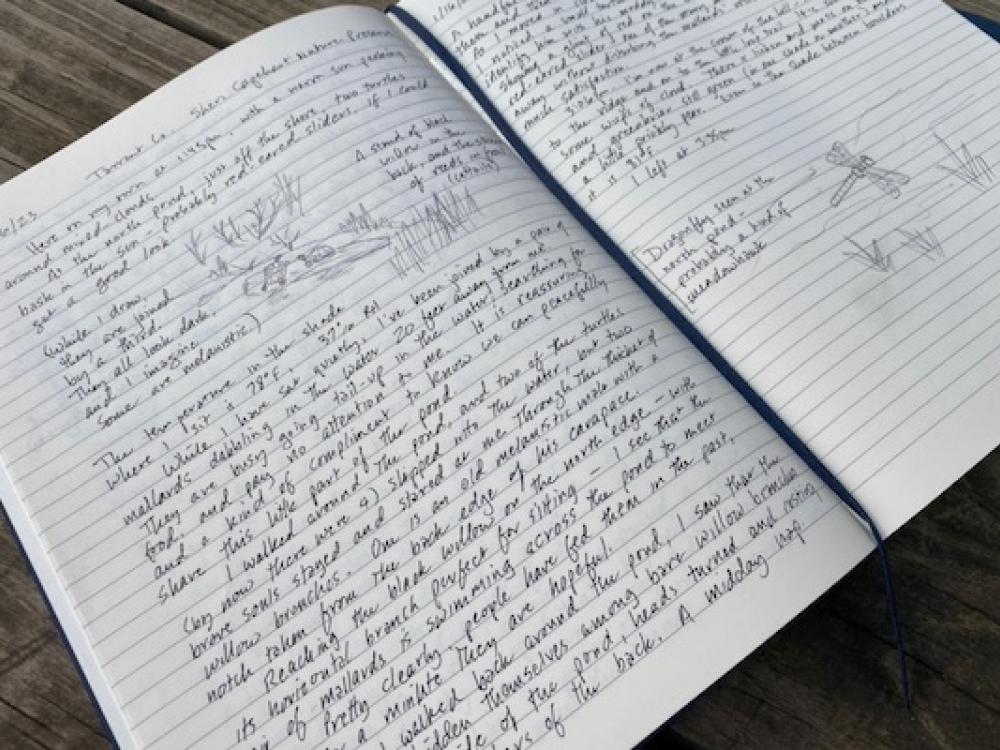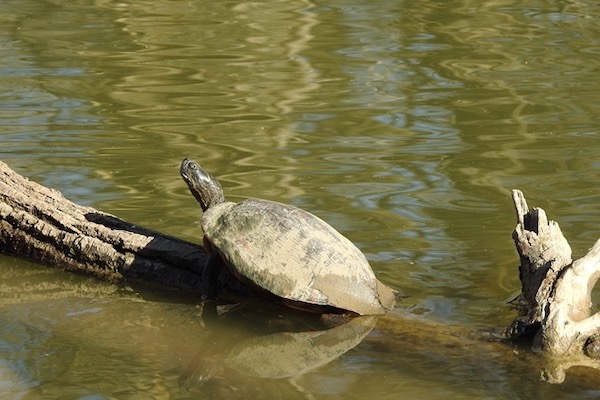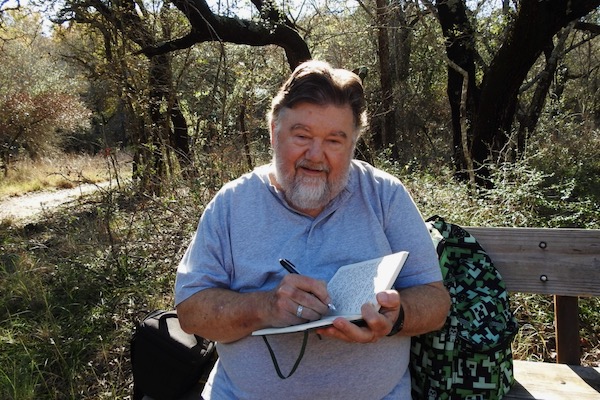
Michael Smith will be hosting a free nature journaling workshop on Jan. 28 at the Sheri Capehart Nature Preserve in Arlington. Photo by Michael Smith.
Jan 17, 2023
Like many other people, I carry a notebook with me into the field. Writing and drawing while in nature helps me notice all the details and put onto paper what it was like, both around and within me.
A page of a nature journal might include a passage like this:
“The bare oak limbs reached upward, branching smaller and smaller like a river delta, dark against the blue sky. They divided into such intricate patterns, reminding me of the bronchial tubes within our lungs that allow us, like the trees, to breathe.”
 Leaf drawing by author Michael Smith.
Leaf drawing by author Michael Smith.
The journal could also include a sketch of those tree branches against the sky, or of one of the leaves on the ground below the tree.
When we draw something, we attend closely to it, take in all its details and bring some of that to the page. So even if we don’t think our drawing is good, the act of nature journaling gives us a richer experience while out on the walk. We will also have a creative and personal reminder of our walk later on.
We can use journaling to help us study nature. If we write and draw, we take time to observe and notice things. Our words and pictures are the record of what we observed of a bird’s flight, or a basking turtle’s plunge into the water, or the way the clouds gather and build before a summer storm.
What we hear and see can lead to questions and things we would like to know more about. We can follow up and add notes to our journal entry. Something like:
“We learned that most of those trees are post oaks, and they usually grow to 40 or 50 feet tall, with bends and twists in the branches and leaves that have blunt, knobby lobes.”
BENEFITS

River Cooter at Fort Worth Nature Center and Refuge. Photo by Michael Smith.
Among the benefits of nature journaling are:
• More refined observation and vocabulary. We look more carefully, pinpoint words we can use to describe what we see and develop the ability to draw it.
• Mindful awareness. As we write or draw while out in nature, we are likely to be pulled into a mindful awareness of the present moment. Journaling isn’t the same as mindfulness, but they can work together.
• Self-reflection. Journaling is a chance to consider what we are drawn to in our surroundings and what emotions, thoughts, and meanings come to us.
• Strengthened memories. Writing about something or drawing it tend to change brief and temporary memories into more permanent recollections. Lots of people use photography to record their experiences, and I usually carry a camera, too. However, we tend to slow down and study things more when we draw or write about them. Also, photos don’t capture sounds. What about other parts of our experience, like smells and the feel of sun, water, trees and plants? Words are good tools for paying attention to and preserving such things.
RESOURCES
Many of us started off documenting our time in the field by taking biological field notes or using iNaturalist. Those are very valuable, but they are a little different from nature journaling. The things that may find their way into a nature journal range from objective facts to the emotional impact a place can have and the meanings that come up along the way.
 There are many resources available for learning how to keep a nature journal. Among them are books like Clare Leslie’s Keeping a Nature Journal (3rd Edition) and John Muir Lawes and Emilie Lygren’s How to Teach Nature Journaling. Laws also has a website with lessons, videos and other resources.
There are many resources available for learning how to keep a nature journal. Among them are books like Clare Leslie’s Keeping a Nature Journal (3rd Edition) and John Muir Lawes and Emilie Lygren’s How to Teach Nature Journaling. Laws also has a website with lessons, videos and other resources.
These resources often emphasize drawing and painting, with some notes and writing that are anchored to the artwork. This can be a great way to keep a nature journal, but a journal that is mostly written is also a wonderful way to strengthen your observation, mindful awareness and attention, build rich memories, and reflect on your day in nature.
Locally, you can look for classes through museums or nature centers.
I will be teaching a free nature journaling workshop with local artist Jessica Smith on Jan. 28 at Sheri Capehart Nature Preserve in Arlington. See details below.
TIPS FOR NATURE JOURNALING
There are lots of practical decisions to be made so that journaling works for you. Generally I stop and sit in order to write and draw.
Before you go n your walk, are there places to sit, or can you carry a small portable camp stool? What materials do you want to carry, depending on whether you are going to write with minimal sketching, or perhaps do more drawing or painting?
Some people buy a fancy notebook and discover they’re less likely to use it for fear of “messing it up.” Better to have something less fancy and fearlessly take chances! Remember, you are not doing it for anyone but yourself.
HURDLES
 A nature journal reflects the creator's unique perspective. Photo by Julie Thibodeaux.
A nature journal reflects the creator's unique perspective. Photo by Julie Thibodeaux.
Common reasons people discourage themselves from keeping a nature journal include:
• I don’t have time. If you don’t stop to take it all in when you’re out in nature, it’s true that you can cover more ground. But you miss the chance to absorb the details, learn and be inspired.
• I can’t write/draw. At some point, none of us could, but then we gave it a try, kept giving it a try, and got better. I believe most of us can, with practice, keep a journal that gives us joy.
• I don’t go to majestic places. What about some nearby place where there are trees or some birds or butterflies? Research tells us that a little bit of time spent in nearby nature is good for us — it doesn’t have to be wilderness. (Check out GreenSourceDFW.org for articles about the many wonderful nature preserves and parks nearby.)
Keeping a nature journal expands your choices for what to do on a walk. Approach it as a sort of experiment in focusing attention and letting the place soak into your body and mind. Play with how much to write or draw and find what’s comfortable. You might find that your notebook, pen and pencils will be among the favorite items in your backpack.
 Author Michael Smith jots notes at the Fort Worth Nature Center and Refuge. Courtesy of Michael Smith.
Author Michael Smith jots notes at the Fort Worth Nature Center and Refuge. Courtesy of Michael Smith.
Getting Started Nature Journaling
About: GSDFW reporter and author Michael Smith and local artist Jessica Smith will lead a nature journaling workshop to share their tips. It is geared for teens through adults. Everyone is welcome, even those who think they cannot draw or write.
When: Jan. 28, 1 p.m. to 2:30 p.m.
Where: Sheri Capehart Nature Preserve, 5201 Bowman Springs Road, Arlington
What to bring: Bring a notebook or paper and a pen and pencil. Bring colored pencils if you like. We recommend keeping it simple. We will shares tips for bringing other supplies. Bring a small camp stool if you choose.
Cost: Free
RELATED ARTICLES
‘Mindfulness’ enhances nature walks
Children should face their fears of the forest
Critter-related phobias can keep us from enjoying nature
Coping tools can help heal 'environmental grief'
Stay up to date on everything green in North Texas, including the latest news and events! Sign up for the weekly Green Source DFW Newsletter! Follow us on Facebook and Twitter. Also check out our new podcast The Texas Green Report, available on your favorite podcast app.









